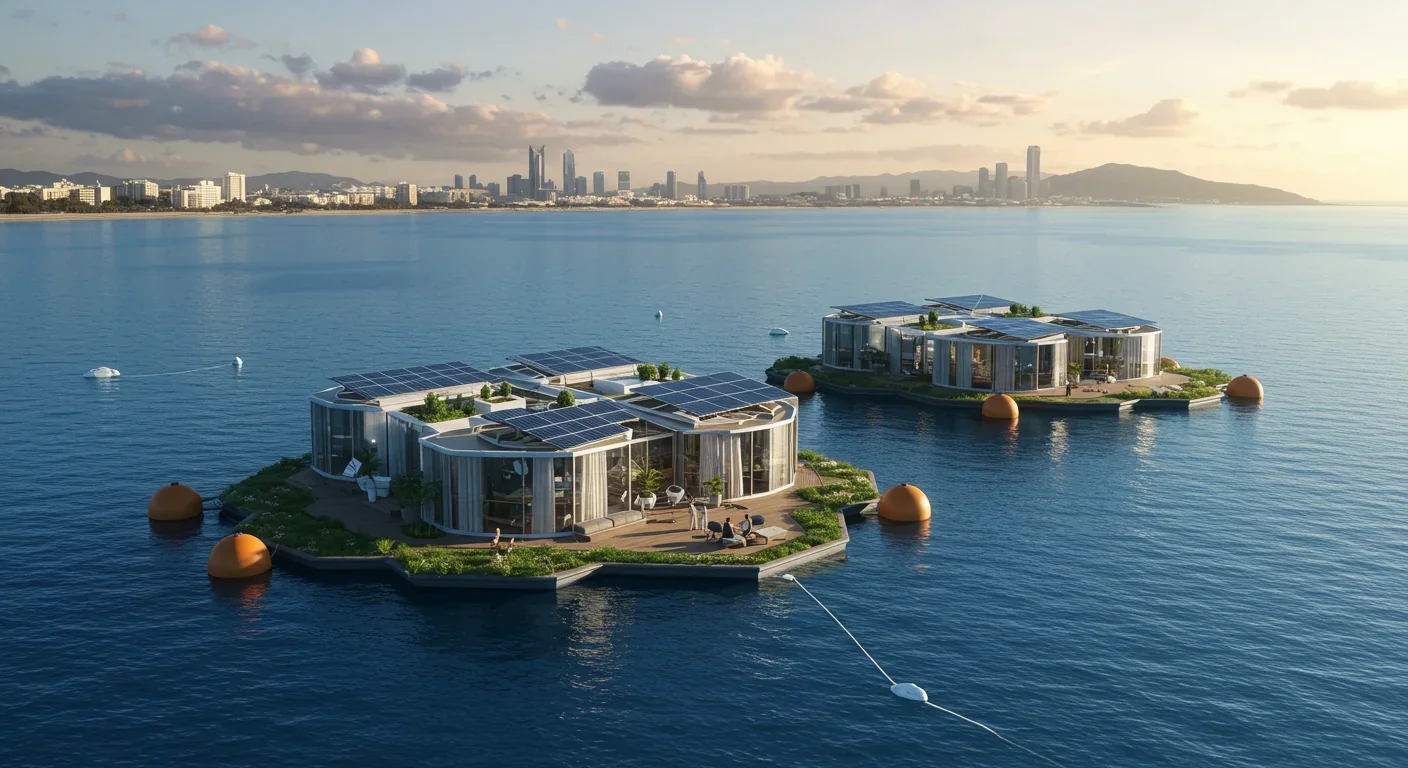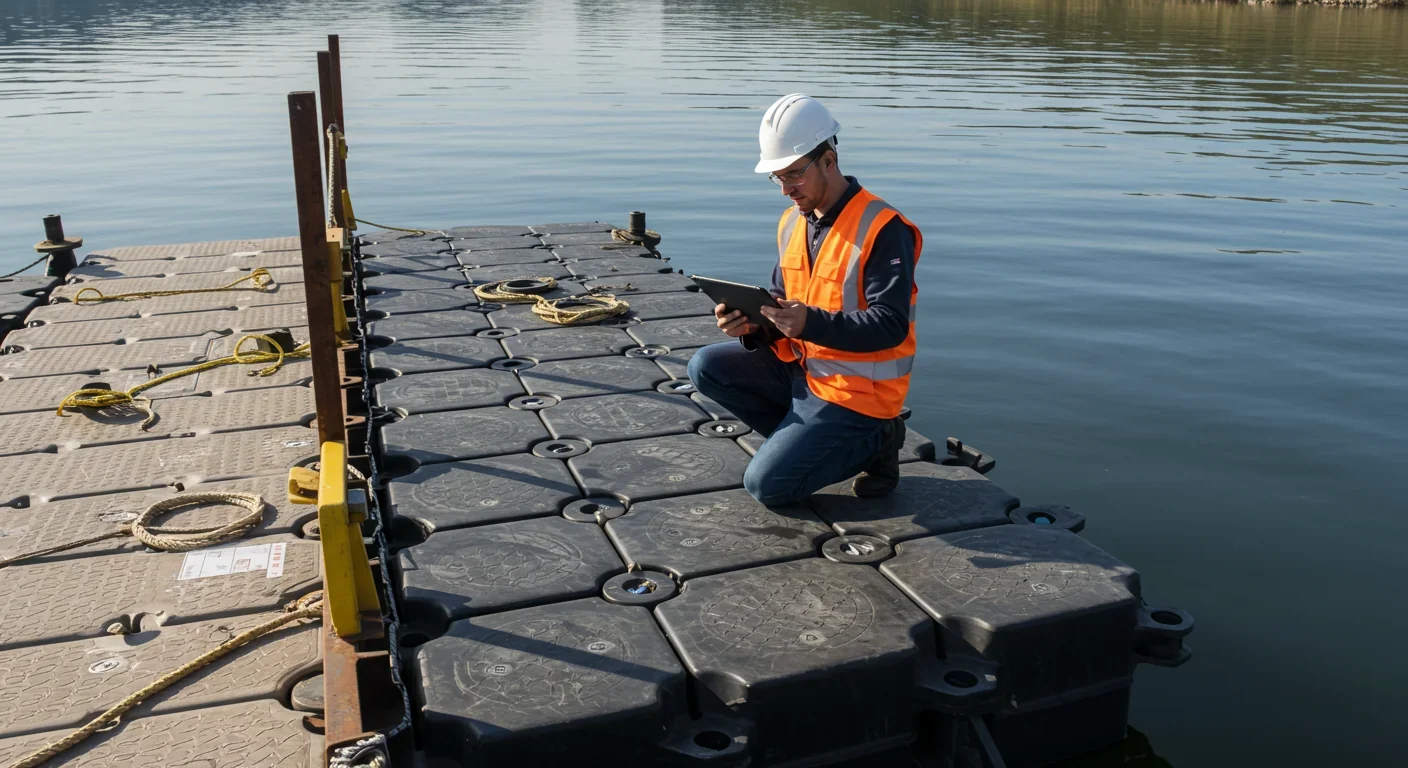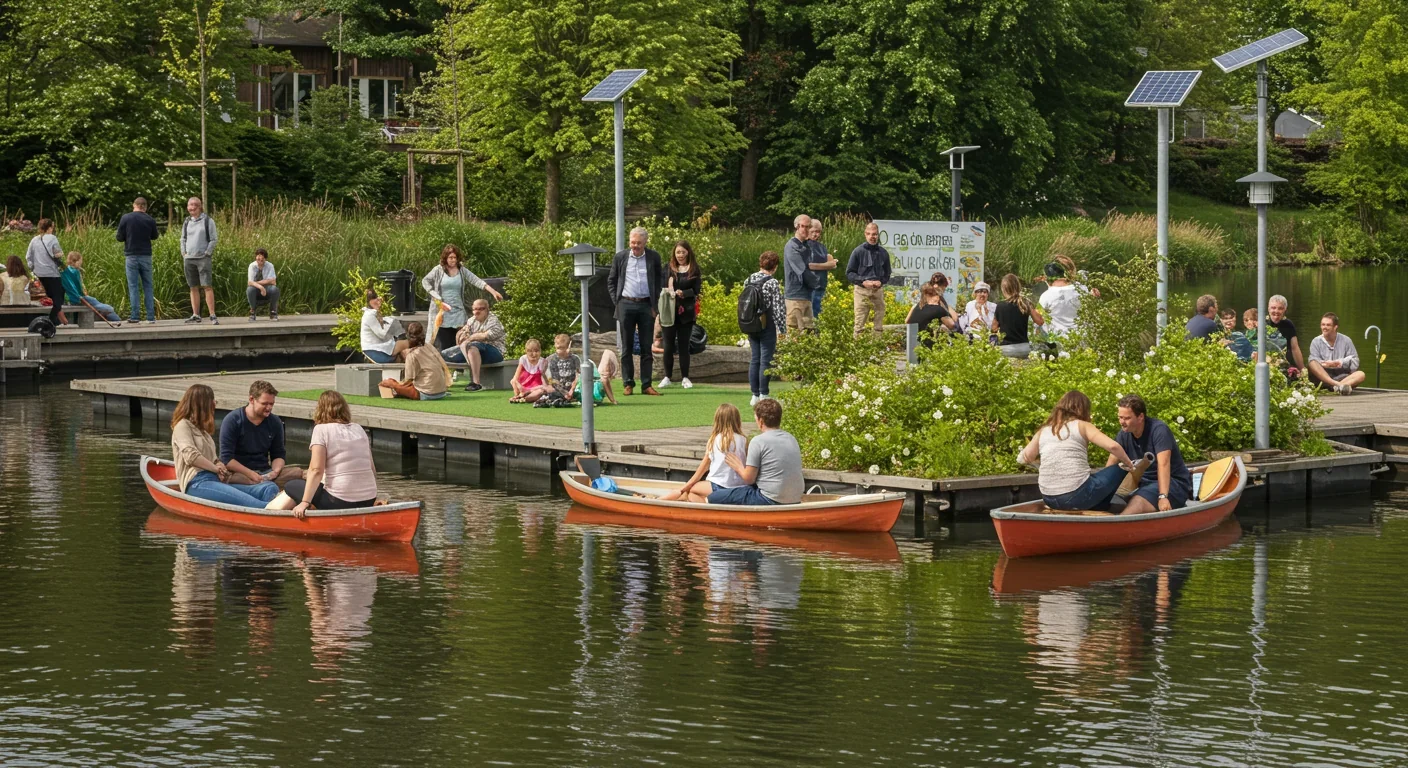Digital Pollution Tax: Can It Save Data Centers?

TL;DR: Floating cities are transitioning from concept to reality as 900 million coastal residents face rising seas. Current prototypes in Busan, Rotterdam, and the Maldives demonstrate engineering breakthroughs in modular construction and sustainable systems, though equity concerns and governance gaps remain critical challenges.

By 2100, sea levels could rise up to 90 centimeters according to worst-case IPCC scenarios—and nearly 900 million people live in coastal zones directly threatened by those rising tides. That's one in ten humans on Earth. But while some communities retreat inland, others are choosing a radically different path: building cities that float.
These aren't crude rafts or temporary shelters. We're talking about engineered urban habitats with schools, parks, renewable energy systems, and waste recycling—entire neighborhoods designed to rise and fall with the waves. The concept sounds like science fiction, yet construction on Oceanix Busan began in 2023, with the first phase slated for completion by 2025. Floating cities are no longer a distant dream. They're happening now.
The idea of living on water isn't new. Indigenous communities in Southeast Asia, houseboats in Amsterdam, and even Venice itself have shown that humans can adapt. What's changed is scale and ambition. Where once we built individual floating homes, today's engineers design modular platforms spanning hundreds of acres, capable of housing tens of thousands.
History teaches us that necessity drives innovation faster than imagination. Just as the printing press democratized knowledge and the internet collapsed distance, rising seas are forcing us to rethink what a city can be. A 2019 study tracking coastal settlement patterns across 155 countries found 56% relocated inland—but 16% actually moved closer to the coast, betting on protective infrastructure and economic opportunities.
Floating cities emerge at this intersection of risk and opportunity. They aren't meant to replace inland migration but to offer another option, especially for island nations like the Maldives and coastal megacities where relocation simply isn't feasible for millions.
Walk onto Oceanix Busan's hexagonal platforms and you're standing on reinforced concrete and steel designed to withstand typhoon-force winds and tsunami surges. Each platform houses around 300 residents and connects to neighbors via flexible walkways that move with the water rather than against it. The entire 15.5-acre prototype can eventually expand to accommodate more than 100,000 people.
"In floating structures, the focus is on stability, durability and flexibility," explains engineer Armin Olthuis. "We must consider the movement of the water, wave impact and possible variations in water levels." That means designing for constant motion. Unlike traditional buildings anchored to bedrock, floating cities need foundations that can handle at least 500 kg per square meter and wave tolerance of 1.5 meters or more.
The breakthrough came through modular construction. Rather than custom-building each component on-site, platforms are prefabricated in shipyards and towed into position. This approach cuts installation costs by 30% compared to traditional methods. Even better, modular designs let cities grow organically—add a platform here, remove one there—without massive reconstruction projects.
Materials matter, too. High-density polyethylene (HDPE) now dominates 68% of new floating installations thanks to UV resistance and durability. Some experimental designs even incorporate "living materials"—marine organisms that grow onto structures, strengthening them over time while creating artificial reefs that support biodiversity.
Then there's the challenge of staying put. Unlike cruise ships that can relocate during storms, floating cities need advanced mooring systems. Recent experiments with air-cushion foundations and taut mooring show that optimizing draft depth and anchor spacing can reduce pitch and roll motions significantly, keeping the city stable even in rough seas.
Building a platform that floats is one thing. Creating a functioning ecosystem is another entirely. Oceanix Busan's design integrates six interconnected systems: zero-waste loops, closed-loop water management, urban farming, net-zero energy, innovative mobility, and coastal habitat regeneration. Let's unpack what that means in practice.
Energy comes from solar panels and wave power, generating enough electricity to meet all resident needs. Excess energy charges batteries for nighttime use or powers desalination plants that convert seawater into drinking water. Every drop of wastewater gets treated and recycled—nothing goes back into the ocean untreated.
Food production happens vertically. Hydroponic gardens and aquaculture farms occupy dedicated platforms, growing vegetables and fish in controlled environments that use 90% less water than traditional agriculture. Waste becomes feedstock: organic scraps turn into compost or biogas, plastics get recycled into building materials, and nothing ends up in landfills because there are no landfills.
Transportation shifts from cars to electric boats, bicycles, and walkways. Without sprawl and with everything designed for compact living, most residents can reach work, school, and shops within a 15-minute walk—or paddle.
Perhaps most intriguing is habitat regeneration. Rather than treating the ocean as empty space to colonize, floating cities can nurture it. Platforms shade the surface, lowering water temperatures in an era of warming seas. Structures designed with porous surfaces create homes for fish, kelp, and coral. New York's floating pool at Pier 35, scheduled for 2026, even includes a custom filtration system that cleans river water as people swim.

Not every floating city dream has succeeded. In fact, most haven't. The cautionary tale begins with Peter Thiel, who in 2008 invested $500,000 to launch The Seasteading Institute. The vision was libertarian paradise: self-governing floating platforms beyond national jurisdiction where innovators could experiment with new social and economic systems.
French Polynesia seemed like the perfect partner. A seven-year memorandum of understanding promised a pilot project in their waters. Then reality intervened. Locals protested what they saw as "techno-colonialism"—wealthy outsiders buying the right to build private islands while contributing little to the existing community. Collins Chen, a former French Polynesian government official, recalls marches in Tahiti where residents demanded the deal be scrapped. It was.
"People will never be able to build a city in the middle of the ocean without an engineering and governance framework that is already proven," says Wayne Gramlich, one of the Seasteading Institute's founders. His words cut to the heart of the problem: ideological enthusiasm preceded technical feasibility.
That failure taught crucial lessons. First, floating cities can't be imposed on communities—they must emerge from genuine need and local buy-in. Second, logistics matter more than ideology. Maritime law, supply chains, and regulatory frameworks need to be in place before the first platform touches water. Third, environmental and social impacts can't be afterthoughts.
Even existing marine infrastructure shows how hard this is. Kansai International Airport in Japan sits on an artificial island that sank 12 meters in its first eight years of operation. Stabilizing it required $20 billion in investments, continuous monitoring, and pumping systems that work around the clock. When Typhoon Jebi hit in 2018, seawater flooded the terminal and damaged the only bridge to the mainland, trapping thousands. "We were trapped," one traveler reported—a stark reminder that floating infrastructure faces unique vulnerabilities.
Here's the uncomfortable question: Will floating cities save vulnerable coastal populations, or become exclusive enclaves for the wealthy?
Professor Peter Newman, a sustainability expert, calls seasteading "a rich people's diversion and has no obvious value" to those most threatened by climate change. The criticism stings because it's partly true. Dubai's Floating Seahorse Villas cater to ultra-luxury tourism, not climate refugees. Early prototypes carry hefty price tags that put them out of reach for the 900 million people actually living in at-risk coastal zones.
This mirrors the inequality already visible in climate adaptation. When forced to relocate, communities only move inland if they have the means, notes researcher Wang Xiaoming. Poorer populations stay put, exposed to rising risks because they lack alternatives. Floating cities could deepen that divide if they become gated islands for elites while everyone else faces flooding.
But they don't have to. Rotterdam's Spoorweghaven project is designed as affordable housing, with over 100 apartments, public spaces, and commercial units aimed at alleviating the city's housing shortage. The key difference: it's driven by municipal planning with public funding and community input, not private profit motives.
Similarly, the Maldives is developing a hexagonal floating city explicitly as a response to existential threat—90% of the nation's land sits less than one meter above sea level. For them, floating cities aren't luxury; they're survival.
If funding mechanisms prioritize equity, floating cities could become climate adaptation infrastructure accessible to vulnerable populations. The Green Climate Fund and Loss and Damage Fund, established through international climate agreements, could in theory finance floating urban habitats for at-risk nations. But right now, those funds lack specific provisions for this type of development.
Floating cities exist in a legal gray zone. Are they ships? Cities? Artificial islands? The answer matters because it determines which laws apply.
Under the UN Convention on the Law of the Sea, artificial islands in territorial waters fall under the jurisdiction of the coastal state. But what happens in international waters? Who regulates construction standards, labor rights, waste disposal, and emergency response? These questions don't have clear answers yet.
Mandatory certifications already exist for floating infrastructure: CE marking for European markets, ABS classification for commercial docks, and IMO guidelines for seawater applications. But these cover engineering standards, not governance of entire communities.
UN-Habitat has begun addressing the gap. At the Second UN Roundtable on Sustainable Floating Cities, participating nations endorsed frameworks specifically for floating urban development. Still, implementation lags. International Geneva hosts organizations like UNEP, IOM, and the International Law Commission—all relevant to climate migration and human rights—but lacks coordination mechanisms tailored to floating cities.
Maritime law creates additional headaches. In the United States, vessels built outside the country cannot sail between American ports, complicating supply chains for territories like Puerto Rico. Similar restrictions exist worldwide, potentially isolating floating cities from critical logistics networks.
The solution will require new multilateral agreements that blend maritime law, urban planning regulations, environmental protections, and human rights frameworks. It's complex—but not unprecedented. International aviation law provides a model for how nations can cooperate on safety standards and jurisdictional questions.

Floating cities resonate differently across cultures. In the Netherlands, where much of the country sits below sea level, water management is national identity. Dutch engineers pioneered floating architecture not as novelty but as necessity. Amsterdam's houseboats and floating pavilions reflect centuries of living with water, not fighting it.
Asia approaches the concept through a lens of rapid urbanization and limited land. Singapore, Hong Kong, and Tokyo face intense pressure to expand without sprawling into agricultural zones or protected areas. Floating platforms offer vertical and lateral growth, keeping suburban green spaces intact while exploiting sea surface area.
For Pacific Island nations, the conversation carries existential weight. Kiribati, Tuvalu, and the Marshall Islands aren't debating whether to adapt—they're deciding whether to relocate entire populations or invest in technologies that let them stay. Floating cities represent sovereignty: the ability to remain in ancestral waters even as those waters rise.
Brazil is exploring the concept through a climate diplomacy lens. AquaPraça, a floating gathering space designed for COP30 in Belém, will travel from Venice to the Amazon, where it becomes permanent cultural infrastructure. The project signals floating architecture as a tool for international collaboration and climate dialogue, not just engineering.
Different motivations, but a common thread: floating cities force us to rethink our relationship with the ocean. Instead of treating it as a barrier or resource to exploit, we're learning to coexist.
The technology is here. Prototypes are being built. The real challenge is social, political, and economic: Can we deploy floating cities equitably? Can governance keep pace with engineering? Can we do this without repeating colonialism's mistakes—imposing solutions on communities that didn't ask for them?
If floating cities succeed, they'll be part of a broader mosaic of climate adaptation. Some communities will relocate inland. Some will build higher seawalls. Some will elevate buildings on stilts. And some will choose to float.
The global floating pontoon market is already growing at 6.8% annually, reaching $3.2 billion in valuation. Investment is flowing. Engineers are refining designs. UN agencies are drafting guidelines.
Within a decade, floating neighborhoods in Busan, Rotterdam, and the Maldives will either prove the concept or reveal fatal flaws we haven't anticipated. Either way, we'll learn. Because the ocean isn't waiting for us to decide. It's rising regardless, and 900 million people need answers.
The question isn't whether humanity can build cities that float. We already are. The question is whether we'll build them wisely, justly, and in time.

Recent breakthroughs in fusion technology—including 351,000-gauss magnetic fields, AI-driven plasma diagnostics, and net energy gain at the National Ignition Facility—are transforming fusion propulsion from science fiction to engineering frontier. Scientists now have a realistic pathway to accelerate spacecraft to 10% of light speed, enabling a 43-year journey to Alpha Centauri. While challenges remain in miniaturization, neutron management, and sustained operation, the physics barriers have ...

Epigenetic clocks measure DNA methylation patterns to calculate biological age, which predicts disease risk up to 30 years before symptoms appear. Landmark studies show that accelerated epigenetic aging forecasts cardiovascular disease, diabetes, and neurodegeneration with remarkable accuracy. Lifestyle interventions—Mediterranean diet, structured exercise, quality sleep, stress management—can measurably reverse biological aging, reducing epigenetic age by 1-2 years within months. Commercial ...

Data centers consumed 415 terawatt-hours of electricity in 2024 and will nearly double that by 2030, driven by AI's insatiable energy appetite. Despite tech giants' renewable pledges, actual emissions are up to 662% higher than reported due to accounting loopholes. A digital pollution tax—similar to Europe's carbon border tariff—could finally force the industry to invest in efficiency technologies like liquid cooling, waste heat recovery, and time-matched renewable power, transforming volunta...

Humans are hardwired to see invisible agents—gods, ghosts, conspiracies—thanks to the Hyperactive Agency Detection Device (HADD), an evolutionary survival mechanism that favored false alarms over fatal misses. This cognitive bias, rooted in brain regions like the temporoparietal junction and medial prefrontal cortex, generates religious beliefs, animistic worldviews, and conspiracy theories across all cultures. Understanding HADD doesn't eliminate belief, but it helps us recognize when our pa...

The bombardier beetle has perfected a chemical defense system that human engineers are still trying to replicate: a two-chamber micro-combustion engine that mixes hydroquinone and hydrogen peroxide to create explosive 100°C sprays at up to 500 pulses per second, aimed with 270-degree precision. This tiny insect's biochemical marvel is inspiring revolutionary technologies in aerospace propulsion, pharmaceutical delivery, and fire suppression. By 2030, beetle-inspired systems could position sat...

The U.S. faces a catastrophic care worker shortage driven by poverty-level wages, overwhelming burnout, and systemic undervaluation. With 99% of nursing homes hiring and 9.7 million openings projected by 2034, the crisis threatens patient safety, family stability, and economic productivity. Evidence-based solutions—wage reforms, streamlined training, technology integration, and policy enforcement—exist and work, but require sustained political will and cultural recognition that caregiving is ...

Every major AI model was trained on copyrighted text scraped without permission, triggering billion-dollar lawsuits and forcing a reckoning between innovation and creator rights. The future depends on finding balance between transformative AI development and fair compensation for the people whose work fuels it.